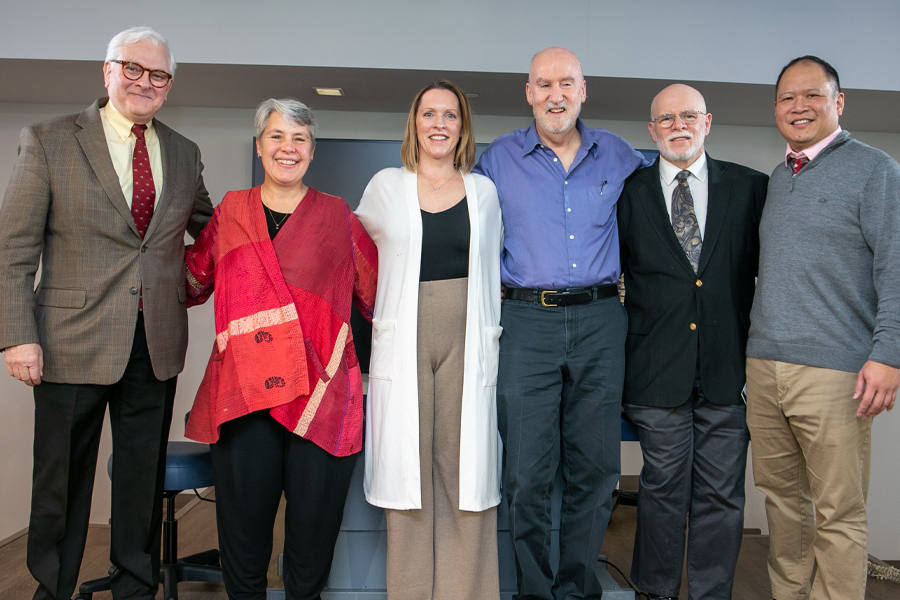
The Strength of the Hispanic Woman
For Hispanic Heritage Month, Chantel Diaz (B.F.A. ’13, M.A. ’15), director of inclusivity and well-being at Live Nation, reflects on the role of women in Hispanic culture and how it has shaped who she is today.
“People think of Latina women as being fiery and fierce, which is usually true. But I think the quality that so many Latinas possess is strength. I’m very proud to have Latin blood.”—Zoe Saldaña, American actress.
According to the Oxford Dictionary, strength is defined as the capacity of an object or substance to withstand great force or pressure.
When I think of strength, I think of my mother, Dionne Diaz. In Hispanic culture, the matriarch is the cornerstone of the family, a symbol of love and leading support of the family. She is both the disciplinarian and the nurturer. She is a homemaker, a martyr, and the best cook in the world (if you let the family tell it). Many social media reels joke about the ‘chancla’ (slipper), which is a feared weapon used by mothers in many Hispanic homes.
The deep-rooted focus on motherhood in Latin cultures likely dates back to the era when European religion took hold in the New World, as native people were converted by missionaries. Conquistadors brought with them the language, culture, and Roman Catholicism from Spain and other southern European countries. Many native cultures, including the Mayans, had many deities, many of whom were female. The fusion of Spanish beliefs with the animistic and magical traditions of pre-Hispanic cultures led to the elevation of Mother Mary as a central figure in Latin American worship. Instead of focusing solely on Jesus, as was common elsewhere, churches, shrines, and sanctuaries across the continent began to be dedicated to the veneration of Mother Mary as early as 1525.
I often think about the strong women in my family and the many roles they take on. Historically in Hispanic culture, the mother figure stays home and caters to the family. In my family, the mothers have managed to keep the household in order and maintain jobs outside of the home. I remember my mom held two jobs and still managed to make it to most of my sporting events and school activities. She made dinner every night and kept our house in order. Now, in my adulthood, I can see how much effort that took. As the oldest daughter, my role was to help my mom. I acted as a second mother figure, learning directly from her. Household duties were a priority, unfortunately, before any fun or even schoolwork. Balancing home life and school life was engrained in me from a young age. I made school lunches for my siblings, walked them to and from school, as well as made dinner from time to time. I believe it has helped me in my current life and given me tons of transferrable skills. Most importantly, the strength of my ancestors. I am so grateful for the doors that have been opened for me through the strength of the women who have come before me.
Happy Latinx Heritage Month!
More News

OMM Lab Rededication Ceremony Honors NYITCOM Founder
On December 6, NYITCOM celebrated the grand reopening and rededication of the NYITCOM Osteopathic Manipulative Medicine Lab, honoring the legacy of Stanley Schiowitz, D.O., founder, chairman, and dean of NYITCOM.

Five Questions With Evan Shieh
Teaching Assistant Professor of Architecture Evan Shieh, M.S. AUD, talks about his research and how self-driving and electric vehicles impact urban environments.

Vancouver Campus Introduces New Master of Data Science
The new program is suited for students in the subspecialties of data science, including data analytics and artificial intelligence.

Unwrapping Narcissistic Gift Giving
This holiday season, research by the School of Management’s Colleen P. Kirk, D.P.S., reveals that narcissists’ gift-giving behavior is all about them.

Sixteen Years of FRIENDS
More than 200 alumni, faculty, staff, students, and friends gathered for the Annual Alumni and FRIENDS Reception to honor three alumni who have made significant impacts in architecture, design, and construction, and celebrate the achievements of faculty and students.

Pharmacy Closures Are a Prescription for Catastrophe
As national retail pharmacy chains collectively shutter thousands of locations nationwide, NYITCOM Associate Professor Maria Pino, Ph.D., explains the potential impact on Long Island, where more than a dozen Rite Aid stores have already disappeared.